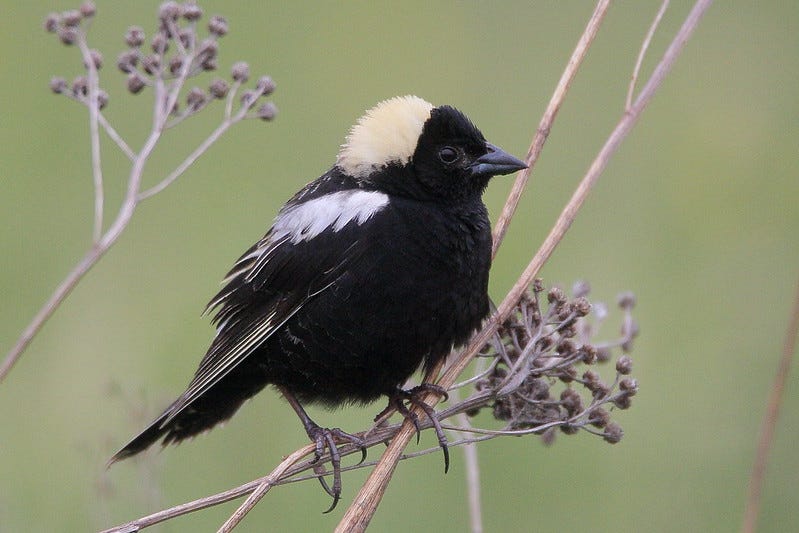Study Up
The first bobolinks will appear during the next two weeks, mostly in the last days of the month. Places where they wouldn’t be surprising are
Silvio O. Conte NWR--Fort River Division
Arcadia Wildlife Sanctuary--Meadows Conservation Area
(These locations are all places where bobolinks have been seen in April in the last five years.)
What bobolinks do and how they sing while they do it make them worth the trip to find. (They often also turn up where there are woodcocks; the next woodcock moon is April 23, but that’s early for bobolinks even at these locations. Still, if you’re out looking for woodcocks, you might get crazy lucky and log the first bobolink on the ground.)
The jumble of sounds in a bobolink’s song fascinates me. While they apparently have at least two songs each — one for courting, and another for warning off other males — that’s just the beginning of the depth of their complexity. Like mockingbirds or winter wrens, individuals build their own songs from phrases that they know.
It doesn’t seem that they are mimics. The phrases aren’t clearly linked to environmental sounds or noises. And because they’re highly migratory, they do seem to maintain a fidelity to a more socially relevant set of musical elements. Somewhere in the winter Argentina haunts they blend together more than they do here in North America when they are on territory.
In looking into the academic research on the song, I see that relatively little has been completed recently, in comparison to other singers that commit to repertoire as a means of demonstrating fitness through versatility.
I find listening to bobolinks exciting and exhilarating. It’s stressful. There’s so much happening in the string of phrases and notes that they assemble, all of which is happening too fast for me to separate it in my ear. Each singing makes an event that I find it hard to interpret before the next one begins. When I first arrive in a bobolink field I try to deconstruct each song. By the time I have been in one for a while, it’s clear that I will not follow the song the way I imagine I could.
There’s a bliss to this resignation. In the furious song of the bobolink is another lesson about letting go.

Focus
This morning I found my fox sparrow. I had asked for advice for a previous newsletter. The secret for today proved to be the reductive skill of listening for what you expect to hear, setting it aside, and thereby hearing what you don’t expect to hear. I came downstairs to make coffee, heard the white-throated sparrows working on their calls — the young ones are left here now, I believe, and they are still working on the plaintive whistle — and the cardinal and the song sparrow. Then I heard a different song. I stood out back with Merlin and confirmed it was the fox. I had seen it a few days before but shied away from a certain ID.
I don’t know how to help anyone, including myself, learn this lesson. I guess there’s something Zen to the idea that you can always listen and then it’s what you hear that you can’t recognize that catches your attention. Anomaly detection is such a relief.
Birdscape
I made my first visit to Southwick Wildlife Management Area. I didn’t have my bike; I wish I had. It’s a strong bobolink location, according to eBird, so I intend to go back later in the spring when the grass is taller and it has more grasslands birds. I miss grasshopper sparrows from when I lived in Nebraska and I would like to see them again there. If you go, be aware that it’s bigger than you might expect, and has long stretches of walking ground with little or no shade. It had a robust breeze the day I went.
It’s been a while since my last newsletter. I had two work trips with added days for birding (25 lifelist birds in Brownsville, Texas). I intend to get closer to weekly through migration. Next week, a deeper look into warblers and global warming.


